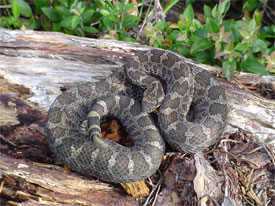
An eastern massasauga rattlesnake. Image: Michigan State University, College of Agriculture & Natural Resources
By Eric Freedman
Michigan’s only venomous snake, the eastern massasauga rattlesnake, has been suspected or proven responsible for at least 75 bites reported in the state from 2003 through 2020, according to the most comprehensive tally ever of such incidents.
However, “only a handful were actually confirmed bites from identified eastern massasaugas,” said Varun Vohra, a clinical toxicologist and director of the Michigan Poison & Drug Information Center at Wayne State University.
None of the bites were fatal, according to a recently published study by researchers from the information center and Detroit Medical Center.
Researchers examined such evidence as puncture wounds, location of the bites on patients’ bodies, symptoms, photos of the snakes and patients’ descriptions to classify cases as positive identification (16%), highly suggestive identification (64%) or low confirmation (20%).
The eastern massasauga is a pit viper native to the Great Lakes region and found mostly in bogs, prairie marshes and grasslands. Most live in Michigan – their “last stronghold,” according to the Michigan Natural Features Inventory, followed by Ontario, but some live in Wisconsin, Minnesota, Pennsylvania, Ohio, Indiana, New York, Iowa and Missouri.
The inventory is a Michigan State University Extension program that collects biodiversity data to help conserve the state’s natural heritage.
The research team analyzed records of bites voluntarily reported to the Poison & Drug Information Center to confirm whether eastern massasaugas were responsible.
They found 80% of victims were men, and 18 cases involved children 17 or younger. Most bites were located on fingers and hands.
Oakland County had the most reported cases with 14, followed by Washtenaw County with 12 and Jackson County with seven.
Other counties with reported cases were Alpena, Montcalm, Crawford, Livingston, Wayne, Genesee, Muskegon, Otsego, Manistee, Kalkaska, Clare, St. Joseph, Ottawa, Montmorency, Isabella, Saginaw, Shiawassee, Ingham, Barry, Kalamazoo and Van Buren.

Counties where eastern massasauga rattlesnake bites were suspected or confirmed from 2003 through 2020. Image: Michigan Poison & Drug Information Center, Wayne State University School of Medicine
The study doesn’t include data from 2021 through early June 2022. The Poison & Drug Information Center had three reports of suspected or confirmed eastern massasauga snakebites in 2021 and two so far in 2022.
“The majority of cases involved folks who were out hiking in and around wetlands when they were reportedly bit,” said Vohra, a co-author of the study published in the scientific journal “Toxicon.”
“There were very few (bites) resulting from an individual actually handling the snake. And I do not believe any were trying to pick one up in the wild to try and keep,” he said.
He said the most common symptoms are edema – swelling – followed by pain and redness. Other symptoms include coughing up blood and a low count of a protein produced by the liver that helps prevent bleeding.
The most frequent treatments were with an antidote, Vohra said, and some victims underwent surgery to relieve increased tissue swelling and pressure.
The Michigan Department of Natural Resources describes eastern massasaugas as “shy creatures that will avoid humans whenever possible. Also known as ‘swamp rattlers,’ they spend the vast majority of their time in year-round wetlands hunting their primary prey, mice.”
They also eat voles, moles, shrews, other snake species and sometimes frogs and birds.
The U.S. Fish and Wildlife Service classifies the eastern massasaugas as a threatened species under the Endangered Species Act.
The Natural Features Inventory website says, “Historically, eastern massasaugas were found throughout the Lower Peninsula and on Bois Blanc Island.”
They cluster in Oakland, Livingston, Jackson and Washtenaw counties in the southeast part of
the state, Allegan, Barry and Kalamazoo counties in Southwest and Iosco, Crawford and
Kalkaska counties in Northern Michigan, according to the inventory website.
“Within the last decade, eastern massasaugas have been reported from about 150 sites in 50 counties,” it said. “Nearly one- third of the historical occurrences in the state has not been reconfirmed in the past 10 years.”
For example, the inventory noted that eastern massasaugas haven’t been reported from Branch, Ingham, Shiawassee, Macomb, Huron, Clare, Oscoda, Montmorency and Emmet counties since before 1980, and some not since the early 1900s.
The study said, “Biologists have confirmed that less than half of the eastern massasauga’s historical populations are in existence, with declining populations attributed to loss and fragmentation of their wetland habitat.”
Other perils are “human persecution or indiscriminate killing, and illegal collection,” according to the Natural Features Inventory.
The DNR cautions, “Rattlesnake bites, while extremely rare in Michigan, can and do occur. Anyone who is bitten should seek medical attention immediately.”